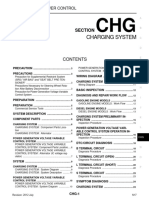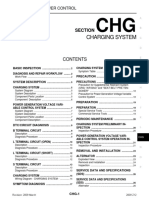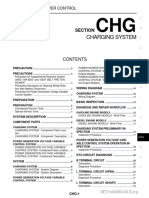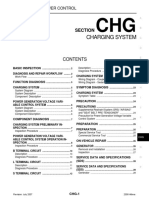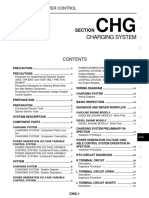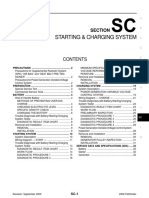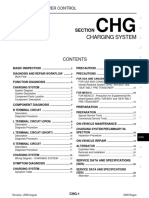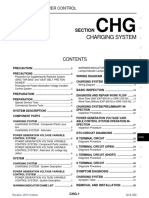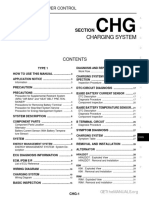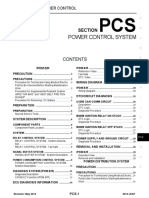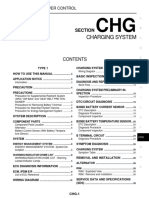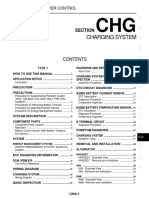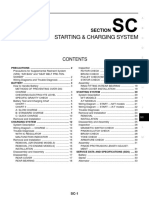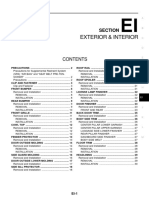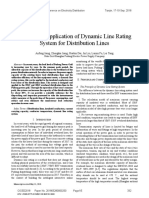Charging System: Section
Charging System: Section
Uploaded by
Dozer KamilCopyright:
Available Formats
Charging System: Section
Charging System: Section
Uploaded by
Dozer KamilOriginal Title
Copyright
Available Formats
Share this document
Did you find this document useful?
Is this content inappropriate?
Copyright:
Available Formats
Charging System: Section
Charging System: Section
Uploaded by
Dozer KamilCopyright:
Available Formats
ELECTRICAL & POWER CONTROL
SECTION CHG
CHARGING SYSTEM
B
E
CONTENTS
PRECAUTION ............................................... 2 POWER GENERATION VOLTAGE VARI- F
ABLE CONTROL SYSTEM OPERATION IN-
PRECAUTIONS ................................................... 2 SPECTION ........................................................ 10
Supplemental Restraint System (SRS) "AIR BAG" Inspection Procedure ...............................................10 G
and "SEAT BELT PRE-TENSIONER" ....................... 2
Precaution for Power Generation Variable Voltage B TERMINAL CIRCUIT ..................................... 12
Control System .......................................................... 2 Description ...............................................................12
H
Diagnosis Procedure ...............................................12
PREPARATION ............................................ 3
L TERMINAL CIRCUIT ..................................... 13
PREPARATION ................................................... 3 Description ...............................................................13 I
Special Service Tool ................................................. 3 Diagnosis Procedure ...............................................13
Commercial Service Tool .......................................... 3
S TERMINAL CIRCUIT ..................................... 14
BASIC INSPECTION .................................... 4 Description ...............................................................14 J
Diagnosis Procedure ...............................................14
DIAGNOSIS AND REPAIR WORKFLOW .......... 4
Work Flow ................................................................. 4 CHARGING SYSTEM ....................................... 15 K
Wiring Diagram ........................................................15
FUNCTION DIAGNOSIS ............................... 7
SYMPTOM DIAGNOSIS .............................. 20
CHARGING SYSTEM .......................................... 7 L
System Diagram ........................................................ 7 CHARGING SYSTEM ....................................... 20
System Description ................................................... 7 Symptom Table .......................................................20
Component Description ............................................ 7 CHG
ON-VEHICLE REPAIR ................................. 21
POWER GENERATION VOLTAGE VARI-
ABLE CONTROL SYSTEM ................................. 8 GENERATOR .................................................... 21
System Diagram ........................................................ 8 Exploded View .........................................................21 N
System Description ................................................... 8 Removal and Installation .........................................21
Component Description ............................................. 8
SERVICE DATA AND SPECIFICATIONS O
COMPONENT DIAGNOSIS .......................... 9 (SDS) ............................................................ 23
CHARGING SYSTEM PRELIMINARY IN- SERVICE DATA AND SPECIFICATIONS
SPECTION ........................................................... 9 (SDS) ................................................................. 23 P
Inspection Procedure ................................................ 9 Generator ................................................................23
Revision: July 2007 CHG-1 2008 Xterra
PRECAUTIONS
< PRECAUTION >
PRECAUTION
PRECAUTIONS
Supplemental Restraint System (SRS) "AIR BAG" and "SEAT BELT PRE-TENSION-
ER" INFOID:0000000003110120
The Supplemental Restraint System such as “AIR BAG” and “SEAT BELT PRE-TENSIONER”, used along
with a front seat belt, helps to reduce the risk or severity of injury to the driver and front passenger for certain
types of collision. This system includes seat belt switch inputs and dual stage front air bag modules. The SRS
system uses the seat belt switches to determine the front air bag deployment, and may only deploy one front
air bag, depending on the severity of a collision and whether the front occupants are belted or unbelted.
Information necessary to service the system safely is included in the SR and SB section of this Service Man-
ual.
WARNING:
• To avoid rendering the SRS inoperative, which could increase the risk of personal injury or death in
the event of a collision which would result in air bag inflation, all maintenance must be performed by
an authorized NISSAN/INFINITI dealer.
• Improper maintenance, including incorrect removal and installation of the SRS, can lead to personal
injury caused by unintentional activation of the system. For removal of Spiral Cable and Air Bag
Module, see the SR section.
• Do not use electrical test equipment on any circuit related to the SRS unless instructed to in this
Service Manual. SRS wiring harnesses can be identified by yellow and/or orange harnesses or har-
ness connectors.
Precaution for Power Generation Variable Voltage Control System INFOID:0000000003110121
CAUTION:
For this model, the battery current sensor that is installed to the negative battery cable measures the
charging/discharging current of the battery and performs various engine controls. If an electrical com-
ponent is connected directly to the negative battery terminal, the current flowing through that compo-
nent will not be measured by the battery current sensor. This condition may cause a malfunction of
the engine control system and battery discharge may occur. Do not connect an electrical component
or ground wire directly to the battery terminal.
Revision: July 2007 CHG-2 2008 Xterra
PREPARATION
< PREPARATION >
PREPARATION A
PREPARATION
Special Service Tool INFOID:0000000003085074
B
Tool number
(Kent-Moore No.) Description C
Tool name
— Tests battery.
(J-48087) For operating instructions, refer to Technical D
Battery Service Center Service Bulletin and Battery Service Center
User Guide.
WKIA5280E
— Tests starting and charging systems. F
(J-44373) Model 620 For operating instructions, refer to Technical
Starting/Charging system tester Service Bulletin.
G
SEL403X
H
J
Commercial Service Tool INFOID:0000000003085075
K
Tool name Description
Power tool Loosening bolts, nuts and screws
CHG
PIIB1407E
Revision: July 2007 CHG-3 2008 Xterra
DIAGNOSIS AND REPAIR WORKFLOW
< BASIC INSPECTION >
BASIC INSPECTION
DIAGNOSIS AND REPAIR WORKFLOW
Work Flow INFOID:0000000003110122
OVERALL SEQUENCE
ALMIA0055GB
DETAILED FLOW
Revision: July 2007 CHG-4 2008 Xterra
DIAGNOSIS AND REPAIR WORKFLOW
< BASIC INSPECTION >
NOTE:
To ensure a complete and thorough diagnosis, the battery, starter and generator test segments must be done A
as a set from start to finish.
1.PRELIMINARY INSPECTION
B
Perform the preliminary inspection. Refer to CHG-9, "Inspection Procedure".
>> GO TO 2
C
2.DISABLE THE POWER GENERATION VOLTAGE VARIABLE CONTROL SYSTEM
Disable the power generation voltage variable control with either of the following procedures.
• After selecting “ENGINE” on the “SELECT SYSTEM” screen of CONSULT-III, set the “ALTERNATOR DUTY” D
value to 0 % by selecting “ALTERNATOR DUTY” with “Active Test”. Continue “Active Test” until the end of
inspection. (When the DUTY value is 0 or 100 %, the normal power generation is performed according to the
characteristic of the IC regulator of the generator.) E
• Turn the ignition switch OFF, disconnect the battery current sensor connector and leave it disconnected dur-
ing the course of the test.
NOTE:
Running the engine with the battery current sensor disconnected will cause DTC's (P1550-P1554) to set. F
After finishing the inspection, connect the battery current sensor connector and erase the self-diagnostic
results history of the engine using CONSULT-III.
G
>> GO TO 3
3.DIAGNOSIS WITH STARTING/CHARGING SYSTEM TESTER H
Perform the charging system test using Starting/Charging System Tester (J-44373). For details and operating
instructions, refer to Technical Service Bulletin.
Test result
I
CHARGING SYSTEM NOMAL>>Charging system is normal and will also show “DIODE RIPPLE” test result.
NO CHARGING VOLTAGE>>GO TO 4
LOW CHARGING VOLTAGE>>GO TO 12
HIGH CHARGING VOLTAGE>>GO TO 14 J
DIODE RIPPLE NORMAL>>Diode ripple is OK and will also show “CHARGING VOLTAGE” test result.
EXCESS RIPPLE DETECTED>>Replace the generator. Perform “DIODE RIPPLE” test again using Starting/
Charging System Tester (J-44373) to confirm repair. K
DIODE RIPPLE NOT DETECTED>>GO TO 4
4.INSPECTION WITH CHARGE WARNING LAMP (IGNITION SWITCH IS ON)
L
Turn the ignition switch ON.
Does the charge warning lamp illuminate?
YES >> GO TO 6
CHG
NO >> GO TO 5
5.TERMINAL“2” (OPEN) CIRCUIT INSPECTION
Check terminal “2” circuit for open circuits. Refer to CHG-13, "Description". N
Is the terminal “2” circuit normal?
YES >> Replace generator. Refer to CHG-21, "Removal and Installation"
NO >> Repair as needed. O
6.INSPECTION WITH CHARGE WARNING LAMP (IDLING)
Start the engine and run it at idle. P
Does the charge warning lamp turn OFF?
YES >> GO TO 9
NO >> GO TO 7
7.TERMINAL “2”(SHORT) CIRCUIT INSPECTION
Check terminal “2” circuit for short to ground. Refer to CHG-13, "Description".
Is the terminal “2” circuit normal?
Revision: July 2007 CHG-5 2008 Xterra
DIAGNOSIS AND REPAIR WORKFLOW
< BASIC INSPECTION >
YES >> GO TO 8
NO >> Repair as needed.
8.TERMINAL“3” CIRCUIT INSPECTION
Check terminal “3” circuit. Refer to CHG-14, "Description".
Is the terminal “3” circuit normal?
YES >> GO TO 10
NO >> Repair as needed.
9.INSPECTION WITH CHARGE WARNING LAMP (ENGINE AT 3,000 RPM)
Increase and maintain the engine speed at 3,000 rpm.
Does the charge warning lamp remain off?
YES >> GO TO 11
NO >> GO TO 10
10.INSPECTION OF GENERATOR PULLEY
Check generator pulley.
Is generator pulley normal?
YES >> Replace generator. Refer to CHG-21, "Removal and Installation".
NO >> Repair as needed.
11.TERMINAL “1” CIRCUIT INSPECTION
Check terminal “1””circuit. Refer to CHG-12, "Description".
Is terminal “1” circuit normal?
YES >> Replace generator. Refer to CHG-21, "Removal and Installation".
NO >> Repair as needed.
12.TERMINAL “1” CIRCUIT INSPECTION
Check terminal “1” circuit. Refer to CHG-12, "Description".
Is terminal “1” circuit normal?
YES >> GO TO 13
NO >> Repair as needed.
13.INSPECTION OF GENERATOR PULLEY
Check generator pulley.
Is generator pulley normal?
YES >> Replace generator. Refer to CHG-21, "Removal and Installation".
NO >> Repair as needed.
14.TERMINAL “3” CIRCUIT INSPECTION
Check terminal“3” circuit. Refer to CHG-14, "Description".
Is the terminal “3” circuit normal?
YES >> Replace generator. Refer to CHG-21, "Removal and Installation".
NO >> Repair as needed.
Revision: July 2007 CHG-6 2008 Xterra
CHARGING SYSTEM
< FUNCTION DIAGNOSIS >
FUNCTION DIAGNOSIS A
CHARGING SYSTEM
System Diagram INFOID:0000000003110123
B
I
ALMIA0207GB
J
System Description INFOID:0000000003110124
The generator provides DC voltage to operate the vehicle's electrical system and to keep the battery charged.
The voltage output is controlled by the IC regulator. K
Component Description INFOID:0000000003110125
L
Component part Description
Terminal “1” Refer to CHG-12, "Description".
CHG
Terminal “2” Refer to CHG-14, "Description".
Generator Terminal “3” Refer to CHG-13, "Description".
Used for the power generation voltage variable control system. N
Terminal “4”
Refer to CHG-8, "System Description".
The IC regulator warning function activates to illuminate the
charge warning lamp if any of the following symptoms occur while
Combination meter (Charge warning lamp) generator is operating:
O
• Excessive voltage is produced.
• No voltage is produced.
Used for the power generation voltage variable control system. P
IPDM E/R
Refer to CHG-8, "System Description".
Revision: July 2007 CHG-7 2008 Xterra
POWER GENERATION VOLTAGE VARIABLE CONTROL SYSTEM
< FUNCTION DIAGNOSIS >
POWER GENERATION VOLTAGE VARIABLE CONTROL SYSTEM
System Diagram INFOID:0000000003110126
ALMIA0057GB
System Description INFOID:0000000003110127
Power generation variable voltage control system has been adopted. By varying the voltage to the generator,
engine load due to power generation of the generator is reduced and fuel consumption is decreased.
NOTE:
When any malfunction is detected in the power generation variable voltage control system, power generation
is performed according to the characteristic of the IC regulator in the generator.
Component Description INFOID:0000000003110128
Component part Description
The battery current sensor is installed on the battery cable at the
negative terminal. The battery current sensor detects the charg-
Battery current sensor
ing/discharging current of the battery and sends a voltage signal
to the ECM according to the current value detected.
The battery current sensor detects the charging/discharging cur-
rent of the battery. The ECM judges the battery condition based on
this signal.
The ECM judges whether to request more output via the power
generation voltage variable control according to the battery condi-
ECM
tion.
When performing the power generation voltage variable control,
the ECM calculates the target power generation voltage according
to the battery condition and sends the calculated value as the pow-
er generation command value to the IPDM E/R.
The IPDM E/R converts the received power generation command
IPDM E/R value into a pulse width modulated (PWM) command signal and
sends it to the IC regulator.
The IC regulator controls the power generation voltage by the tar-
get power generation voltage based on the received PWM com-
mand signal.
Generator (IC regulator)
When there is no PWM command signal, the generator performs
the normal power generation according to the characteristic of the
IC regulator.
Revision: July 2007 CHG-8 2008 Xterra
CHARGING SYSTEM PRELIMINARY INSPECTION
< COMPONENT DIAGNOSIS >
COMPONENT DIAGNOSIS A
CHARGING SYSTEM PRELIMINARY INSPECTION
Inspection Procedure INFOID:0000000003110129
B
1.CHECK BATTERY TERMINALS CONNECTION
Check if battery terminals are clean and tight. C
Is the inspection result normal?
YES >> GO TO 2
NO >> Repair battery terminals connection. D
2.CHECK FUSE
Check for blown fuse and fusible link. E
Unit Power source (Power supply terminals) Fuse or Fusible Link
Generator Battery (terminal 3) Fuse 30
F
Battery (terminal 1) Fusible Link A
Combination meter Ignition switch ON (terminal 2) Fuse 14
Is the inspection result normal? G
YES >> GO TO 3
NO >> Be sure to eliminate cause of malfunction before installing new fuse or fusible link.
H
3.CHECK GENERATOR GROUND TERMINAL CONNECTION
Verify connector E209 terminal 5 (generator ground harness) is clean and tight.
Is the inspection result normal? I
YES >> GO TO 4
NO >> Repair connection.
4.CHECK DRIVE BELT TENSION J
Check drive belt tension. Refer to EM-12, "Checking Drive Belts".
Is the inspection result normal?
K
YES >> Inspection End.
NO >> Repair as needed.
L
CHG
Revision: July 2007 CHG-9 2008 Xterra
POWER GENERATION VOLTAGE VARIABLE CONTROL SYSTEM OPERATION
INSPECTION
< COMPONENT DIAGNOSIS >
POWER GENERATION VOLTAGE VARIABLE CONTROL SYSTEM OPER-
ATION INSPECTION
Inspection Procedure INFOID:0000000003110130
CAUTION:
When performing this inspection, always use a charged battery that has completed the battery inspec-
tion. (When the charging rate of the battery is low, the response speed of the voltage change will
become slow. This can cause an incorrect inspection.)
1.CHECK ECM (CONSULT-III)
Perform ECM self-diagnosis with CONSULT-III. Refer to EC-68, "CONSULT-III Function (ENGINE)".
Self-diagnostic results content
No malfunction detected>> GO TO 2
Malfunction detected>> Check applicable parts, and repair or replace corresponding parts.
2.CHECK OPERATION OF POWER GENERATION VOLTAGE VARIABLE CONTROL SYSTEM
1. Connect CONSULT-III and start the engine.
2. The selector lever is in “P” or “N” position and all of the electric loads and A/C, etc. are turned OFF.
3. Select “ALTERNATOR DUTY” in “Active Test” of “ENGINE”, and then check the value of “BATTERY
VOLT” monitor when DUTY value of “ALTERNATOR DUTY” is set to 40.0 %.
“BATTERY VOLT”
2 seconds after setting the : 12 - 13.6 V
DUTY value of “ALTERNA-
TOR DUTY” to 40.0 %
4. Check the value of “BATTERY VOLT” monitor when DUTY value of “ALTERNATOR DUTY” is set to
80.0%.
“BATTERY VOLT”
20 seconds after setting : +0.5 V or more against
the DUTY value of “ALTER- the value of “BATTERY
NATOR DUTY” to 80.0 % VOLT” monitor when
DUTY value is 40.0 %
Is the measurement value within specification?
YES >> Inspection End.
NO >> GO TO 3
3.CHECK IPDM E/R (CONSULT-III)
Perform IPDM E/R self-diagnosis with CONSULT-III. Refer to EC-68, "CONSULT-III Function (ENGINE)".
Self-diagnostic results content
No malfunction detected>> GO TO 4
Malfunction detected>> Check applicable parts, and repair or replace corresponding parts.
4.CHECK HARNESS BETWEEN GENERATOR AND IPDM E/R
1. Turn ignition switch OFF.
2. Disconnect generator connector E205 and IPDM E/R connector
E122.
3. Check continuity between generator harness connector E205
(A) terminal 4 and IPDM E/R harness connector E122 (B) termi-
nal 37.
A B
Continuity
Connector Terminal Connector Terminal
E205 4 E122 37 Yes ALMIA0196ZZ
Revision: July 2007 CHG-10 2008 Xterra
POWER GENERATION VOLTAGE VARIABLE CONTROL SYSTEM OPERATION
INSPECTION
< COMPONENT DIAGNOSIS >
4. Check continuity between generator harness connector E122 (A) terminal 4 and ground.
A
A
— Continuity
Connector Terminal
B
E205 4 Ground No
Are the continuity test results as specified?
YES >> Replace IPDM E/R. Refer to PCS-35, "Removal and Installation of IPDM E/R". C
NO >> Repair harness or connector between IPDM E/R and generator.
CHG
Revision: July 2007 CHG-11 2008 Xterra
B TERMINAL CIRCUIT
< COMPONENT DIAGNOSIS >
B TERMINAL CIRCUIT
Description INFOID:0000000003110131
The terminal “1” (B) circuit supplies power to charge the battery and operate the vehicles electrical system.
Diagnosis Procedure INFOID:0000000003110132
1.CHECK TERMINAL “1” CONNECTION
1. Turn ignition switch OFF.
2. Verify terminal “1” is clean and tight.
Is the inspection result normal?
YES >> GO TO 2
NO >> Repair terminal “1” connection. Confirm repair by performing complete Starting/Charging system
test. Refer to Technical Service Bulletin.
2.CHECK TERMINAL “1” CIRCUIT
Check voltage between generator connector E206 terminal 1 and
ground.
(+)
(-) Voltage
Connector Terminal
E206 1 Ground Battery voltage
Is voltage reading as specified?
YES >> GO TO 3.
NO >> Check harness for open between generator and fusible
ALMIA0197ZZ
link.
3.CHECK TERMINAL “1” CONNECTION (VOLTAGE DROP TEST)
1. Start engine, then engine running at idle and warm.
2. Check voltage between battery positive terminal and generator
connector E206 terminal 1.
(+)
(-) Voltage
Connector Terminal
E206 1 Battery positive terminal Less than 0.2V
Is the voltage reading as specified?
YES >> Terminal “1” circuit is normal. Refer to CHG-4, "Work
ALMIA0198ZZ
Flow".
NO >> Check harness between battery and generator for high resistance.
Revision: July 2007 CHG-12 2008 Xterra
L TERMINAL CIRCUIT
< COMPONENT DIAGNOSIS >
L TERMINAL CIRCUIT
A
Description INFOID:0000000003110133
The terminal “2” (L) circuit controls the charge warning lamp. The charge warning lamp illuminates when the B
ignition switch is set to ON or START. When the generator is providing sufficient voltage with the engine run-
ning, the charge warning lamp will go off. If the charge warning lamp illuminates with the engine running, a
malfunction is indicated.
C
Diagnosis Procedure INFOID:0000000003110134
1.CHECK CHARGE WARNING LAMP CIRCUIT CONNECTION D
Verify generator connector E205 terminal 2 is clean and tight.
Is the connection secure?
YES >> GO TO 2 E
NO >> Repair the connection. Confirm repair by performing complete Starting/Charging system test.
Refer to Technical Service Bulletin.
2.CHECK CHARGE WARNING LAMP CIRCUIT F
1. Disconnect generator connector E205.
2. Apply ground to generator harness connector E205 terminal 2
with the ignition switch in the ON position. G
Charge lamp should illuminate
H
Does the charge lamp illuminate?
YES >> Check generator function. Refer to CHG-4, "Work Flow".
NO >> GO TO 3
I
ALMIA0200ZZ
J
3.CHECK HARNESS CONTINUITY
1. Turn ignition switch OFF.
2. Disconnect the generator connector E205 and combination K
meter connector M24.
3. Check continuity between generator harness connector E205
(A) terminal 2 and combination meter harness connector M24
L
(B) terminal 2.
Terminal Terminal
Continuity CHG
Connector Terminal Connector Terminal
E205 2 M24 2 Yes AWMIA0499ZZ
4. Check continuity between generator harness connector E205 N
(A) terminal 2 and ground.
Terminal — O
Continuity
Connector Terminal
E205 2 Ground No
P
Are the continuity results as specified?
YES >> Replace the combination meter. Refer to IP-10, "Removal and Installation".
NO >> Repair the harness or connector.
Revision: July 2007 CHG-13 2008 Xterra
S TERMINAL CIRCUIT
< COMPONENT DIAGNOSIS >
S TERMINAL CIRCUIT
Description INFOID:0000000003110135
The output voltage of the generator is controlled by the IC regulator at terminal “3” (S) detecting the input volt-
age. Terminal “3” circuit detects the battery voltage to adjust the generator output voltage with the IC regulator.
Diagnosis Procedure INFOID:0000000003110136
1.CHECK VOLTAGE REGULATOR CIRCUIT CONNECTION
Check to see if connector E205 terminal 3 is clean and tight.
Is the inspection result normal?
YES >> GO TO 2
NO >> Repair terminal connection. Confirm repair by performing complete Starting/Charging system test.
Refer to Technical Service Bulletin.
2.CHECK VOLTAGE REGULATOR CIRCUIT
Check voltage between generator harness connector E205 terminal
3 and ground.
3 - ground Battery voltage
Does battery voltage exist?
YES >> Refer to CHG-4, "Work Flow".
NO >> Check harness for open between generator and fuse.
ALMIA0201ZZ
Revision: July 2007 CHG-14 2008 Xterra
CHARGING SYSTEM
< COMPONENT DIAGNOSIS >
CHARGING SYSTEM
A
Wiring Diagram INFOID:0000000003110137
CHG
P
AWMWA0119G
Revision: July 2007 CHG-15 2008 Xterra
CHARGING SYSTEM
< COMPONENT DIAGNOSIS >
AWMIA0207GB
Revision: July 2007 CHG-16 2008 Xterra
CHARGING SYSTEM
< COMPONENT DIAGNOSIS >
CHG
AWMIA0208GB
Revision: July 2007 CHG-17 2008 Xterra
CHARGING SYSTEM
< COMPONENT DIAGNOSIS >
AWMIA0209GB
Revision: July 2007 CHG-18 2008 Xterra
CHARGING SYSTEM
< COMPONENT DIAGNOSIS >
CHG
AWMIA0210GB
Revision: July 2007 CHG-19 2008 Xterra
CHARGING SYSTEM
< SYMPTOM DIAGNOSIS >
SYMPTOM DIAGNOSIS
CHARGING SYSTEM
Symptom Table INFOID:0000000003110138
Symptom Reference
Battery discharged
The charge warning lamp does not illuminate when the ignition
switch is set to ON.
The charge warning lamp does not turn OFF after the engine Refer to CHG-4, "Work Flow".
starts.
The charging warning lamp turns ON when increasing the engine
speed.
Revision: July 2007 CHG-20 2008 Xterra
GENERATOR
< ON-VEHICLE REPAIR >
ON-VEHICLE REPAIR A
GENERATOR
Exploded View INFOID:0000000003243295
B
WKIA3191E J
1. Generator 2. Engine block 3. Generator stay
Removal and Installation INFOID:0000000003085093
K
REMOVAL
L
1. Disconnect the negative battery terminal.
2. Remove the fan shroud. Refer to CO-15, "Exploded View".
3. Remove the drive belt. Refer to EM-12, "Removal and Installation". CHG
4. Remove the generator stay, using power tools.
5. Remove the generator upper bolt, using power tools.
6. Disconnect the generator harness connectors. N
7. Remove the generator.
INSTALLATION O
Installation is in the reverse order of removal.
• Install the generator and check the tension of the drive belt. Refer to EM-12, "Checking Drive Belts".
P
Terminal "1" nut : 10.8 N·m (1.1 kg-m, 8 ft-lb)
CAUTION:
Tighten terminal "1" nut carefully.
• For this model, the power generation variable voltage control system that controls the power generation volt-
age of the generator has been adopted. Therefore, the power generation variable voltage control system
inspection should be performed after replacing the generator in order to ensure that the system operates
normally.
Revision: July 2007 CHG-21 2008 Xterra
GENERATOR
< ON-VEHICLE REPAIR >
GENERATOR PULLEY INSPECTION
Perform the following.
• Make sure that the generator pulley does not rattle.
• Make sure that the generator pulley nut is properly tightened.
Generator pulley nut : 118 N·m (12.0 kg-m, 87 ft-lb)
Revision: July 2007 CHG-22 2008 Xterra
SERVICE DATA AND SPECIFICATIONS (SDS)
< SERVICE DATA AND SPECIFICATIONS (SDS)
SERVICE DATA AND SPECIFICATIONS (SDS) A
SERVICE DATA AND SPECIFICATIONS (SDS)
Generator INFOID:0000000003085094
B
LR1130-701
Type C
Valeo
Engine VQ40DE
Nominal rating 12V-130A D
Ground polarity Negative
Minimum revolution under no-load (When 13.5
1,200 rpm E
volts is applied)
More than 82A/1800rpm
Hot output current (When 13.5 volts is applied) More than 115A/2,500rpm
More than 130A/5,000rpm F
Regulated output voltage 14.1 - 14.7V @ 20°C
Adjustment range of power generation variable
11.4 - 15.6V
voltage control G
CHG
Revision: July 2007 CHG-23 2008 Xterra
You might also like
- Nissan Titan Power Control SystemDocument98 pagesNissan Titan Power Control SystemDaniel Aguirre100% (2)
- Aquastato Manometro TermometroDocument3 pagesAquastato Manometro Termometroing_pablonicolasNo ratings yet
- Thailand - ASEAN Renewable Energy Report 2021Document148 pagesThailand - ASEAN Renewable Energy Report 2021Nam Hoai Le100% (1)
- Charging System: SectionDocument23 pagesCharging System: SectionederengNo ratings yet
- CHG PDFDocument23 pagesCHG PDFronaldNo ratings yet
- Charging System: SectionDocument22 pagesCharging System: Sections.e. e.p.No ratings yet
- Charging System: SectionDocument29 pagesCharging System: Sectiongiancarlo sanchezNo ratings yet
- CHG PDFDocument22 pagesCHG PDFIvan A. VelasquezNo ratings yet
- CHGNNDocument29 pagesCHGNNmobismxNo ratings yet
- Charging System: SectionDocument26 pagesCharging System: SectionKunji ManiNo ratings yet
- Charging System: SectionDocument29 pagesCharging System: Sectionjoeldqcgh29No ratings yet
- Charging System: SectionDocument57 pagesCharging System: SectionLuis GarcíaNo ratings yet
- Charging System: SectionDocument25 pagesCharging System: SectionWilmer Elias Quiñonez HualpaNo ratings yet
- Charging SystemDocument24 pagesCharging SystemNapiNo ratings yet
- Nissan Sentra 2016Document31 pagesNissan Sentra 2016wilder0l0pezNo ratings yet
- Charging System: SectionDocument30 pagesCharging System: SectionYB MOTOR Nissan - Datsun SpecialistNo ratings yet
- Charging System: SectionDocument34 pagesCharging System: SectionHakob AdamyanNo ratings yet
- Charging System: SectionDocument30 pagesCharging System: SectionIvan A. VelasquezNo ratings yet
- Charging System: SectionDocument31 pagesCharging System: Sectionratatrampa25No ratings yet
- Charging System: SectionDocument27 pagesCharging System: SectionCarlos Tito AmésquitaNo ratings yet
- Charging System: SectionDocument40 pagesCharging System: SectionhuusonbachkhoaNo ratings yet
- Xterra2007 EncendidoDocument38 pagesXterra2007 EncendidoGabriel GarciaNo ratings yet
- Charging System: SectionDocument30 pagesCharging System: SectioncesarNo ratings yet
- Nissan CHGDocument26 pagesNissan CHGjasleenNo ratings yet
- Charging System: SectionDocument30 pagesCharging System: SectionZona Educación Especial ZacapaoaxtlaNo ratings yet
- CHG PDFDocument30 pagesCHG PDFSebastián PeñaNo ratings yet
- 2007 Nissan Frontier 18Document42 pages2007 Nissan Frontier 18Mardelis cisnerosNo ratings yet
- Charging System: SectionDocument35 pagesCharging System: Sectionpenk ypNo ratings yet
- Steering Control System: SectionDocument22 pagesSteering Control System: SectionAgustin Borge GarciaNo ratings yet
- Charging System: SectionDocument34 pagesCharging System: SectionJumadi AlkutsNo ratings yet
- Power Control System: SectionDocument96 pagesPower Control System: Sectionluis CebergNo ratings yet
- Charging System: SectionDocument35 pagesCharging System: SectionnicobushNo ratings yet
- Charging System: SectionDocument28 pagesCharging System: SectionLuis Alfonso Ortiz ESpinosaNo ratings yet
- Charging System: SectionDocument55 pagesCharging System: SectionLíder DieselNo ratings yet
- Charging System: SectionDocument33 pagesCharging System: SectionsKardoNo ratings yet
- CHG PDFDocument39 pagesCHG PDFMie GorengRacerNo ratings yet
- Charging System: SectionDocument35 pagesCharging System: SectionH. Yusmira (Kang Otto)No ratings yet
- SC PDFDocument36 pagesSC PDFRony CentenoNo ratings yet
- Starting & Charging System: SectionDocument32 pagesStarting & Charging System: SectionLino Bello RezamanoNo ratings yet
- SC PDFDocument32 pagesSC PDFLino Bello RezamanoNo ratings yet
- Charging System: SectionDocument22 pagesCharging System: SectionelectrolabmedicdsNo ratings yet
- Power Control System: SectionDocument100 pagesPower Control System: SectiontecnicofigueroaNo ratings yet
- Charging SysDocument31 pagesCharging SysLucasNo ratings yet
- Charging System: SectionDocument28 pagesCharging System: SectionPetter VillarroelNo ratings yet
- Starting & Charging System: SectionDocument32 pagesStarting & Charging System: Sectionq6md2qdmhpNo ratings yet
- SC PDFDocument38 pagesSC PDFROSILENE PASSOSNo ratings yet
- Starting & Charging System: SectionDocument36 pagesStarting & Charging System: Sectionmuki461100% (2)
- CHG - Charging SystemDocument57 pagesCHG - Charging SystemErsin AliNo ratings yet
- Steering Control System: SectionDocument23 pagesSteering Control System: Sectionhajiamani531No ratings yet
- PcsDocument71 pagesPcsgsmsbyNo ratings yet
- Starting and Charging SystemDocument26 pagesStarting and Charging SystemJagdeep Sekhon100% (2)
- Starting Charging SystemDocument30 pagesStarting Charging SystemErickson GarciaNo ratings yet
- Charging System: SectionDocument29 pagesCharging System: SectionRuhu royNo ratings yet
- Charging System: SectionDocument48 pagesCharging System: SectionАндрей Надточий100% (2)
- Starting & Charging System: SectionDocument30 pagesStarting & Charging System: SectionOuc RegistryNo ratings yet
- Power Control System: SectionDocument80 pagesPower Control System: SectionAliNo ratings yet
- Charging System: SectionDocument55 pagesCharging System: Sectionjair Hernandez100% (1)
- Nissan-Versa 2015 EN US Manual de Taller Ecu Modulo Carroceria Relay-Of-Ventilador Radiador Etc A21c4b9aaa.Document72 pagesNissan-Versa 2015 EN US Manual de Taller Ecu Modulo Carroceria Relay-Of-Ventilador Radiador Etc A21c4b9aaa.victor borja100% (1)
- Power Control System: SectionDocument85 pagesPower Control System: SectionALexis IbacetaNo ratings yet
- SC PDFDocument34 pagesSC PDFAldo ApazzaNo ratings yet
- Starting & Charging System: SectionDocument34 pagesStarting & Charging System: Sectionjokim mnroNo ratings yet
- Build Hat Serial ProtocolDocument17 pagesBuild Hat Serial ProtocolDozer KamilNo ratings yet
- Raspberry Pi Build Hat Product BriefDocument6 pagesRaspberry Pi Build Hat Product BriefDozer KamilNo ratings yet
- Build Hat Python LibraryDocument14 pagesBuild Hat Python LibraryDozer KamilNo ratings yet
- High Accuracy, Galvanically Isolated Current Sensor IC With Small Footprint SOIC8 PackageDocument23 pagesHigh Accuracy, Galvanically Isolated Current Sensor IC With Small Footprint SOIC8 PackageDozer KamilNo ratings yet
- Body Control System: SectionDocument52 pagesBody Control System: SectionDozer KamilNo ratings yet
- 3vu1300-1mh00 Siemens Manual DatasheetDocument12 pages3vu1300-1mh00 Siemens Manual DatasheetDozer KamilNo ratings yet
- Exterior & Interior: SectionDocument30 pagesExterior & Interior: SectionDozer KamilNo ratings yet
- Audio, Visual & Telephone System: SectionDocument16 pagesAudio, Visual & Telephone System: SectionDozer KamilNo ratings yet
- Pvi 7200 Wind Interface 0Document20 pagesPvi 7200 Wind Interface 0KarbonKaleNo ratings yet
- Tutorial of Non-Isolated DC/DC Converters in Continuous ModeDocument15 pagesTutorial of Non-Isolated DC/DC Converters in Continuous ModeSudip MondalNo ratings yet
- Efficient Power Factor Imp. TechDocument4 pagesEfficient Power Factor Imp. Techsadia_murshad171No ratings yet
- Battery Charger - Function TestDocument2 pagesBattery Charger - Function TestSofiane ChouNo ratings yet
- Site Acceptance Test Report For MV Panel - J03: Al Hudayriyat Island Tmp4Document6 pagesSite Acceptance Test Report For MV Panel - J03: Al Hudayriyat Island Tmp4Gajendran SriramNo ratings yet
- 05 Overcurrent Protection of Transformer (NEC 450.3)Document14 pages05 Overcurrent Protection of Transformer (NEC 450.3)George CisnerosNo ratings yet
- T 1000 PLUS: Secondary Injection Relay Test SetDocument8 pagesT 1000 PLUS: Secondary Injection Relay Test SetKrisada ThongkamsaiNo ratings yet
- DeSuperheaterDocument3 pagesDeSuperheatermn_sundaraamNo ratings yet
- 63 Attachment 6 FormulasDocument3 pages63 Attachment 6 Formulas10222027No ratings yet
- Reference Guide To Schematic DiagramsDocument14 pagesReference Guide To Schematic Diagramsgeorgel1980No ratings yet
- Babcock and Wilcox Boiler Parts:: Wilcox in The Year 1967Document23 pagesBabcock and Wilcox Boiler Parts:: Wilcox in The Year 1967Paras gurungNo ratings yet
- MacdonellDocument4 pagesMacdonellJoseNo ratings yet
- Sample WBS StructureDocument12 pagesSample WBS StructureAlhad KhistiNo ratings yet
- The Advantage and Disadvantage of Nuclear PowerDocument1 pageThe Advantage and Disadvantage of Nuclear PowerFaishal Khairul UmamNo ratings yet
- DC Ring Motor Powers 600-Lb. Thrust Ducted-FanDocument1 pageDC Ring Motor Powers 600-Lb. Thrust Ducted-FanAndrew WhippleNo ratings yet
- BOQ CoalIndiaDocument1 pageBOQ CoalIndiaAkshay KumarNo ratings yet
- 65NRPC NoticeDocument2 pages65NRPC NoticeTarun HingoraniNo ratings yet
- Parts List: (MX-GT90) (MX-GT80)Document27 pagesParts List: (MX-GT90) (MX-GT80)Ariel NiedoNo ratings yet
- SPV Technological Architecture-RECIPMT-as Per Common PPT TempletDocument46 pagesSPV Technological Architecture-RECIPMT-as Per Common PPT Templetsyed hasan 19210064No ratings yet
- Autarco Compatibility Battery Overview ENDocument3 pagesAutarco Compatibility Battery Overview ENAnselmo Aguado cortesNo ratings yet
- Design and Application of Dynamic Line Rating System For Distribution LinesDocument5 pagesDesign and Application of Dynamic Line Rating System For Distribution Linesmoham akhNo ratings yet
- Poster 2023 IEEE PESGM1562 V1Document1 pagePoster 2023 IEEE PESGM1562 V1omorenaNo ratings yet
- Drive Transformers: Advanced Materials - The Key To ProgressDocument12 pagesDrive Transformers: Advanced Materials - The Key To ProgresslosmilzoNo ratings yet
- Electrical Drawing 073016 - CTRLDocument127 pagesElectrical Drawing 073016 - CTRLAM76100% (1)
- RJSINGLEDocument88 pagesRJSINGLEAbhishek TiwariNo ratings yet
- Thermal Review-2018Document199 pagesThermal Review-2018RAVI BHARDWAJNo ratings yet
- Chapter 4 Example and AnswerDocument9 pagesChapter 4 Example and AnswerSayuti SidikNo ratings yet
- Generator Protection Theory and LogicDocument32 pagesGenerator Protection Theory and LogicEr Jitender Kumar100% (2)




















